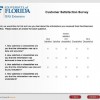 A useful process for developing a high-quality questionnaire follows four steps. Brainstorm questions on a topic. Review the literature for concepts, questions, and indices. Collect ideas for questions and wording choices through focus groups or key informant interviews. And select questions linked to a program’s logic model. Each of these steps is discussed in this 3-page fact sheet written by Glenn D. Israel and Jessica L. Gouldthorpe, and published by the UF Department of Agricultural Education and Communication, August 2013.
A useful process for developing a high-quality questionnaire follows four steps. Brainstorm questions on a topic. Review the literature for concepts, questions, and indices. Collect ideas for questions and wording choices through focus groups or key informant interviews. And select questions linked to a program’s logic model. Each of these steps is discussed in this 3-page fact sheet written by Glenn D. Israel and Jessica L. Gouldthorpe, and published by the UF Department of Agricultural Education and Communication, August 2013.
http://edis.ifas.ufl.edu/pd065
Tag: Glenn D. Israel
The Savvy Survey #13: Online Surveys
 As part of the Savvy Survey Series, this publication provides Extension faculty with an overview of the process that uses email to invite participants to complete an on-line survey. This 10-page fact sheet provides guidance for constructing an online questionnaire, addressing visual design and formatting considerations, and implementing an online survey. Written by Glenn D. Israel and Jessica L. Gouldthorpe, and published by the UF Department of Agricultural Education and Communication, August 2013.
As part of the Savvy Survey Series, this publication provides Extension faculty with an overview of the process that uses email to invite participants to complete an on-line survey. This 10-page fact sheet provides guidance for constructing an online questionnaire, addressing visual design and formatting considerations, and implementing an online survey. Written by Glenn D. Israel and Jessica L. Gouldthorpe, and published by the UF Department of Agricultural Education and Communication, August 2013.
http://edis.ifas.ufl.edu/pd077
The Savvy Survey #1: Introduction
 This initial publication in the Savvy Survey Series provides Extension faculty who are interested in creating savvy surveys with a brief introduction to survey design and basic considerations to make when choosing to use a survey for program planning and evaluation. The publication also provides an introduction to and overview of the Savvy Survey Series in Appendix A. This 5-page fact sheet was written by Jessica L. Gouldthorpe and Glenn D. Israel, and published by the UF Department of Agricultural Education and Communication, August 2013.
This initial publication in the Savvy Survey Series provides Extension faculty who are interested in creating savvy surveys with a brief introduction to survey design and basic considerations to make when choosing to use a survey for program planning and evaluation. The publication also provides an introduction to and overview of the Savvy Survey Series in Appendix A. This 5-page fact sheet was written by Jessica L. Gouldthorpe and Glenn D. Israel, and published by the UF Department of Agricultural Education and Communication, August 2013.
http://edis.ifas.ufl.edu/pd061
Capturing Change: Comparing Pretest-Posttest and Retrospective Evaluation Methods (WC135)
 Two models that are commonly used in Extension programming to capture change over a short period of time are the pretest-posttest model and the retrospective pretest (or post-then-pre) model. When deciding which model to use, Extension professionals should keep in mind that each participant has a knowledge base that includes both factual information and perceptions pertaining to factual information. As you read about the strengths and weaknesses of these two design models, consider how each model fits the evaluation situation to select the one that can best measure change in your program. This 4-page fact sheet was written by Agricultural Education and Communication, and published by the UF Department of Jessica L. Gouldthorpe and Glenn D. Israel, January 2013.
Two models that are commonly used in Extension programming to capture change over a short period of time are the pretest-posttest model and the retrospective pretest (or post-then-pre) model. When deciding which model to use, Extension professionals should keep in mind that each participant has a knowledge base that includes both factual information and perceptions pertaining to factual information. As you read about the strengths and weaknesses of these two design models, consider how each model fits the evaluation situation to select the one that can best measure change in your program. This 4-page fact sheet was written by Agricultural Education and Communication, and published by the UF Department of Jessica L. Gouldthorpe and Glenn D. Israel, January 2013.
http://edis.ifas.ufl.edu/wc135
Using Secondary Data to Build Strong Extension Programs (PEOD10/PD010)
 In planning extension programming, collecting and analyzing information about client needs can be expensive and time consuming. This 4-page fact sheet describes the benefits and limitations of using secondary data, how to evaluate it, and ways to locate quality secondary data. Written by Cheri Winton Brodeur, Glenn D. Israel, and Diane D. Craig, and published by the UF Department of Agricultural Education and Communication, October 2011.
In planning extension programming, collecting and analyzing information about client needs can be expensive and time consuming. This 4-page fact sheet describes the benefits and limitations of using secondary data, how to evaluate it, and ways to locate quality secondary data. Written by Cheri Winton Brodeur, Glenn D. Israel, and Diane D. Craig, and published by the UF Department of Agricultural Education and Communication, October 2011.
http://edis.ifas.ufl.edu/pd010
What is an Extension Program? (WC108)
This 3-page fact sheet provides a definition for the term program and discusses the primary components included in a program. Written by Glenn Israel, Amy Harder, and Cheri Winton Brodeur , and published by the UF Department of Agricultural Education and Communication, May 2011.
http://edis.ifas.ufl.edu/wc108
Evaluating Extension Programs (WC109)
Is program evaluation just a “necessary evil” for Extension program implementation? Or, rather, an opportunity to identify and document accomplishments and discover ways to strengthen the impact of programs? This 5-page fact sheet defines evaluation, explains why evaluation is important to Extension programming beyond accountability requirements, describes how UF/IFAS Extension agents are currently evaluating their programs, and makes suggestions for future evaluation efforts that will showcase the value of Extension programming to the public. Written by Alexa J. Lamm, Glenn D. Israel, David Diehl, and Amy Harder , and published by the UF Department of Agricultural Education and Communication, May 2011.
http://edis.ifas.ufl.edu/wc109
WC106 Logic Model Basics
WC106, a 5-page illustrated fact sheet by Glenn D. Israel, explains what logic models are and provides steps for creating a basic logic model. Includes references. Published by the UF Department of Agricultural Education and Communication, October 2010.
http://edis.ifas.ufl.edu/wc106
WC090 Evaluation Situations, Stakeholders & Strategies
WC090, a 4-page illustrated fact sheet by Glenn Israel, David Diehl, and Sebastian Galindo-Gonzalez, provides guidelines for extension faculty to tailor their evaluation activities to balance their available time and resources with the situation, as well as their individual and stakeholders’ needs. Includes references. Published by the UF Department of Agricultural Education and Communication, November 2009.
http://edis.ifas.ufl.edu/WC090
AEC377/WC058 Reporting Clientele Contact in Workload
Revised! AEC377, a 7-page illustrated fact sheet by Diane D. Craig, Bryan D. Terry, and Glenn D. Israel, describes for UF/IFAS Extension faculty how the WORKLOAD application should be used to report Extension contacts. Includes references. Published by the UF Department of Agricultural Education and Communication, November 2009.
http://edis.ifas.ufl.edu/wc058
WC088 Characteristics of Small Farm Operators in Florida: Economics, Demographics, and Preferred Information Channels and Sources
WC088, an 11-page illustrated report by Steven A. Gaul, Robert C. Hochmuth, Glenn D. Israel, and Danielle Treadwell, summarizes the results from the 2008 University of Florida IFAS Extension–Florida Agricultural and Mechanical University (FAMU) Small Farm Survey. This information can then be used by Extension faculty to identify target audiences, develop relevant materials, and deliver this information through appropriate channels to assist farmers in achieving the goals of their small farm enterprises. Includes references. Published by the UF Department of Agricultural Education and Communication, July 2009.
http://edis.ifas.ufl.edu/WC088
AEC389/WC070 Extension Program and Customer Satisfaction: Are We Serving All Clients Well?
AEC-389, a 5-page illustrated fact sheet by Sebastian Galindo-Gonzalez, Glenn D. Israel, Marna Weston, and Kathryn A. Israel, explores whether race or gender have an effect on the perceptions of the clientele regarding the quality and outcome of services provided by Extension. Includes references. Published by the UF Department of Agricultural Education and Communication, May 2008.
http://edis.ifas.ufl.edu/WC070
AEC 387/PD036 Using Focus Group Interviews for Planning or Evaluating Extension Programs
AEC-387, a 6-page illustrated fact sheet by Glenn D. Israel and Sebastian Galindo-Gonzalez, provides a brief overview of the focus group interview and suggestions for conducting such interviews. Published by the UF Department of Agricultural Education and Communication, May 2008.
http://edis.ifas.ufl.edu/PD036